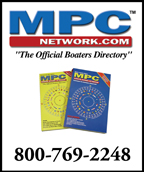|
 |
|
Stepping Softly on the Bay: Leave No Trace
By Lisa Klassen
Sometimes we can be just a little careless
about how we treat our waters. The effects of polluting
oceans aren’t as immediately visible as say, dropping
garbage on the ground, and it’s a lot harder to tell when
we’ve been abusing the ocean’s abundance. Just because we
can’t always see those effects doesn’t mean they aren’t
impacting the environment and our health. Earth Month is a
perfect time for a refresher course on how to maintain the
natural beauty and cleanliness of our Bay by some easy
steps:
A. CLEAN CAREFULLY
• Minimize the need for cleaning products by washing
frequently
with plain water and a sponge or nonabrasive pad.
• When detergents are necessary, use
soaps that are phosphate-free, biodegradable, and
non-toxic. For more information, contact
Green Seal at www.greenseal.org or (202) 872–6400, Consumers
Union at www.eco-labels.org.
• Read product labels.
Avoid products containing ingredients listed in the Glossary
of Toxic Pollutants.
• Use all cleaning products sparingly and minimize the
amount
discharged into the water. While environmentally responsible
products are far less harmful than bleaches, scouring
powders, and detergents, they can still be
toxic to aquatic life. Never dispose of any cleaning
products down
through the thru-hull drain; dispose of them on shore.
B. MAINTAIN MINDFULLY
• Collect paint chips from the hull
and dispose in regular trash. Heavy metals in paint can harm
bottom- dwelling creatures, and thus disrupt the aquatic
food chain.
• Collect all dust and residue and dispose of in regular
trash. Heavy metals, nutrients, and other
pollutants can adhere to dust and
be released to water.
C. RECYCYLE REGULARLY
• Call (800) CLEANUP for the
locations of used oil recycling and hazardous waste disposal
facilities.
• Recycle used oil, oil filters, and antifreeze.
And remember, every little bit helps. If we can all try to
step softly on the Bay, we’ll have a much better chance of
maintaining the charm of the waterfront and all it has to
offer. Not just for the human population, but for the birds,
mammals, and fish that depend on the purity of the water to
exist in a healthy way. The best way to maintain abundance
is to respect and cherish it.
Curious to know more about how you can keep the Bay clean?
The Baykeeper is a valuable source of environmental
information:
http://www.baykeeper.org/ |
|
 |
|
Advertisement |
 |
| |
|